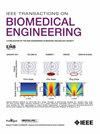Human–Robot Shared Control for Osteotomy Procedure
IF 4.5
2区 医学
Q2 ENGINEERING, BIOMEDICAL
引用次数: 0
Abstract
Spinal intervention can benefit from advancements in robotic systems, particularly in the field of Human-Robot Interaction (HRI). Despite their potential, robotic technologies remain limited to selected spine procedures. Meanwhile, complex and time-consuming procedures, such as osteotomy, are still performed manually, impacting surgeon workload and stress. This paper introduces a robotic system to assist surgeons during the drilling of the vertebral body, enhancing precision and improving patient outcomes. The system integrates a pre-planning tool for establishing the desired correction angle, a virtual fixture-based impedance control algorithm to assist the user in following cutting trajectories while safeguarding surrounding structures, and a navigation tool for enhanced procedural guidance. The system consists of a 7 Degree-of-Freedom robotic manipulator equipped with a drilling system attached to its end-effector. System accuracy was validated on 5 vertebral phantoms, achieving tracking errors of 0.39截骨手术的人机共享控制。
脊柱干预可以受益于机器人系统的进步,特别是在人机交互(HRI)领域。尽管这些技术有很大的潜力,但它们与脊柱手术的结合仍然相对有限,主要包括选定的手术。与此同时,诸如截骨术等复杂且耗时的手术仍需手动进行,这极大地影响了外科医生的工作量和压力。本文介绍了一种辅助外科医生在椎体钻孔过程中的机器人系统。该系统旨在减少外科医生的工作量,提高手术精度,并最终有助于改善脊柱手术患者的预后。该系统集成了一个预先规划工具,用于建立所需的校正角度,一个基于虚拟夹具的阻抗控制算法,使机器人能够在保护周围结构的同时帮助用户遵循预定义的切割轨迹,以及一个导航工具,用于在过程中增强指导。该系统由一个7自由度的机械臂组成,其末端执行器配有一个钻井系统。在5个椎体模型上验证了系统的精度,跟踪误差分别为mm和mm,余量误差分别为mm和mm,矢状面和冠状面角对准误差分别为和。此外,用真实的猪骨对该系统的性能进行了评估,结果表明该系统在真实力学性能下具有相似的精度和鲁棒性。进行了用户研究,以评估与手动控制策略相比,所提出的系统是否有效地提高了用户性能并减轻了用户的工作量。结果表明,当使用提议的系统时,减少了与期望路径的偏差(轨迹误差),并且减少了系统超出预定限制区域(边界违反)的实例。此外,与传统的控制策略相比,参与者认为拟议的系统对精神和身体的要求更低。
本文章由计算机程序翻译,如有差异,请以英文原文为准。
求助全文
约1分钟内获得全文
求助全文
来源期刊

IEEE Transactions on Biomedical Engineering
工程技术-工程:生物医学
CiteScore
9.40
自引率
4.30%
发文量
880
审稿时长
2.5 months
期刊介绍:
IEEE Transactions on Biomedical Engineering contains basic and applied papers dealing with biomedical engineering. Papers range from engineering development in methods and techniques with biomedical applications to experimental and clinical investigations with engineering contributions.
 求助内容:
求助内容: 应助结果提醒方式:
应助结果提醒方式:


